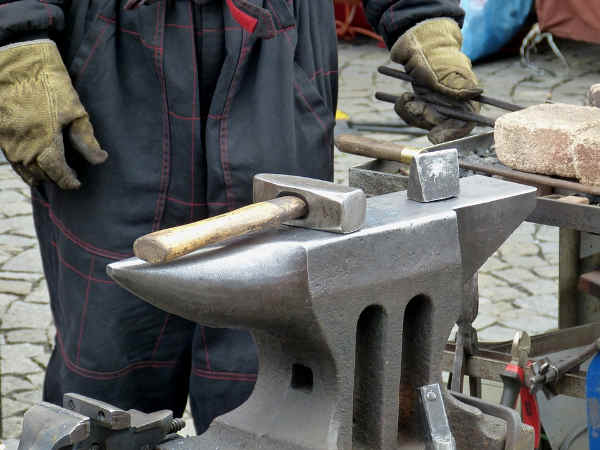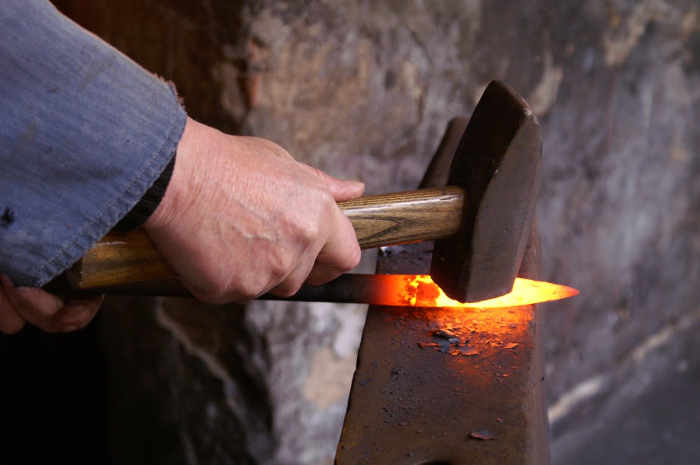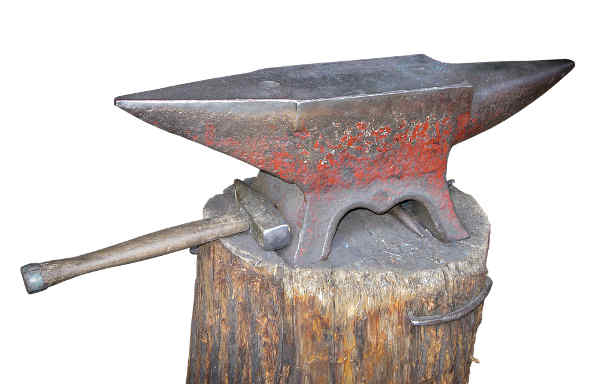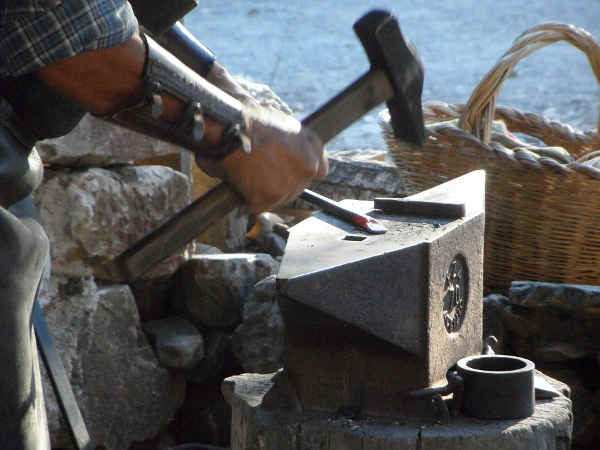If you’ve seen blacksmiths in a movie, or even if you’ve taken a course, you’ve probably seen someone tap their anvil with their hammer. What’s the deal with that?
Why do blacksmiths tap the anvil with their hammer during forging? Blacksmiths might tap the anvil with their hammer for multiple reasons. Some do it to calibrate their grip and swing. Others tap to take a brief rest, or to signal if they’re working with another person. Other blacksmiths are strongly opposed to tapping and really dislike the practice.
Those who don’t like tapping say it’s just a bad habit. But is that true? I’d say no. It really does serve a purpose. Several of them actually.
Tapping the anvil is a technique that helps you forge better and avoid extra unnecessary work for your muscles.
In this article, I’m going to explain all the reasons and benefits that many blacksmiths cite for tapping their anvils with their hammer between strikes.
Reasons Why Blacksmiths Tap Their Anvils
Blacksmiths might choose to tap their anvils for any of the following reasons. Some blacksmiths do it for one specific reason, while others use tapping for multiple different purposes.
It gives you a moment to stop and think
Especially when you’re doing delicate work, you don’t want to hit your work unless you’re sure what you want to do, or you can make a big change to it.
Tapping your anvil gives you a brief window of time to stop and think if you’re not sure where you want to hit next.

It’s more efficient than stopping
It often takes more work to stop your hammer and then start it going again than to just bounce it off the anvil.
If you set the hammer down, you’ve got to pick it back up. If you hold the hammer in the air, you have to support the weight of it. But by bouncing you get a little bit of a rest, and the hammer comes back up to a striking position by the time you’re ready to start again.
For little moments where you just need a second to reposition your work, tapping the anvil provides just the right amount of time you need.
It helps you to calibrate
When a blacksmith first picks up their hammer to start forging, it isn’t in the right position or at the right angle if it was just laying on the anvil. Tapping your anvil throws your hammer up into the air a bit and gives you a chance to regrip it properly.
Tapping your hammer when you first pick it up also helps to let you know exactly where your hammer face is in relation to your swing.
While working, your hand might slip on the hammer a bit as well. Tapping gives you a chance to reposition your hand.
It gives you a moment of rest
Tapping the anvil is letting the hammer freefall for a moment. Even if a tap is only a tiny moment of relief, it helps, especially toward the end of a long smithing session.
It’s a way to signal between two people

Tapping can be a signaling method between the smith and their striker. When multiple people are working around an anvil, it might be too loud to talk easily. Tapping gets your message across quickly without having to look up or talk. Every shop and blacksmith will have its own slightly different meaning for different taps.
Usually a double tap on the anvil is used by the smith to signal that the steel needs to be heated up again, or something needs to be adjusted.
It keeps your rhythm going
Some blacksmiths want to keep the rhythm going while they’re moving a piece of steel or examining their work. Tapping the anvil lets you pause briefly to take a look at your work without losing the rhythm they’ve got going.

It’s just a habit
Some blacksmiths might tap just because that’s the way they learned it from their mentor. Or they might not know why they do it at all. Others just do it because it looks, sounds, and looks cool. Plus that’s how you see blacksmiths do it in the movies.
Simply a difference of technique
Blacksmiths that favor lighter hammer weights tend to tap the anvil more than those who use heavier hammers. (Want to see what hammer I recommend? Check out my gear page!)
It seems counter-intuitive because a heavy hammer has more momentum, so you think that tapping would be more useful. But tapping tends to be favored by those who make lighter, quicker blows compared to those who make more heavy and deliberate blows.
At the end of the forging process
When you’re just starting to forge something, you’re just upsetting or drawing down a bar. There’s a lot less that you need to think about at that point. You’re just trying to move as much metal as you can. Tapping isn’t needed much at this stage.
Later in the forging process, there’s less hammering and brute force involved, and you switch more to tuning and tapping, and smoothing out hammer marks. You’re moving less metal, and movements need to become more accurate and deliberate. This is when frequent observation, thinking, and rests are important, and when blacksmiths will tap the anvil most.
To cool their hammer
Some blacksmiths feel like they need to cool down the hammer between strikes if it starts to get too hot. Blacksmithing hammers are quite heat resistant, and it’s unlikely that enough heat would transfer from the steel you’re working on to the hammer enough to affect it. So this is one explanation that I probably give less credence to than the others.
To avoid scale
Scale is oxidized steel that forms as the heated metal you’re working makes contact with the air. Some blacksmiths think that tapping to take a break between strikes will result in the creation of less scale, or help to avoid scale from accumulating on their hammer.

Why Shouldn’t You Tap The Anvil? What The Anti-Tapping People Say
There are some very strong opinions both for and against tapping. Those who are anti-tapping are often very vocal about it. Some will even refuse to work with or learn from a tapper.
To those who oppose tapping, they think the whole practice is just a waste of energy that serves no purpose. In their eyes, tapping is just making a bunch of unnecessary noise, and ruins the face of your anvil and your hammer.
Conclusion
Tapping the anvil is a technique that plenty of blacksmiths use, while others have a certain disdain for the practice.
Those who tap the anvil have multiple reasons for doing so, including to calibrate their grip and swing, to take a brief rest, or to signal if they’re working with another person.
Tapping is a choice and you can choose to either do it or not do it. It won’t make a huge difference to your work. At most it might save your arm a bit of wear, but wear out your tools slightly more.
When you do hit the anvil with your hammer, be sure to only tap the anvil rather than striking it. Pounding directly on an anvil can deform the surface slightly, which will get transferred over on to any pieces you work on in the future.
Related Questions
Q: Why do blacksmiths hit the sword they’re working on?
A: Blacksmiths hit a piece of metal during the process of shaping it into a sword. When a piece of steel is heated to a certain temperature, it becomes soft enough that it can be shaped. First they’ll draw it out into the general shape of a sword, and then hit it to create a tapered edge.
Q: Why do blacksmiths quench in oil?
A: Some types of alloys need to be quenched in oil instead of water. The rate that oil cools down metal (also known as the quenching velocity) is a lot lower than that of water. The more gradual cooling prevents alloys from cracking or deforming. However, oil quenching results in a less hard piece of steel. Oil also oxidizes and forms a sludge during quenching, which has to be cleaned off the piece afterward.
Do you tap the anvil while you’re working, or do you hate it?

